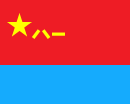People's Liberation Army Air Force
| People's Liberation Army Air Force 中国人民解放军空军 |
|
|---|---|

People's Liberation Army Air Force emblem
|
|
| Founded | November 11, 1949 |
| Country |
|
| Allegiance | Communist Party of China |
| Branch | People's Liberation Army |
| Type | Air force |
| Role | Aerial warfare |
| Size | 398,000 active personnel Approx. 2,755 to 3,010+ aircraft |
| Engagements | Korean War, Vietnam War, Sino-Vietnamese War |
| Commanders | |
| Commander | General Ma Xiaotian |
| Political Commissar | Lt Gen Yu Zhongfu |
| Insignia | |
| Flag |  |
| Roundel |  |
| Low Visibility Roundel |  |
| Aircraft flown | |
| Attack | Q-5, JH-7 |
| Bomber | JH-7, H-6 |
| Electronic warfare |
KJ-200, KJ-2000. |
| Fighter | J-16, J-11, J-10, J-8II, J-7, Su-27, Su-30MKK |
| Interceptor | J-8II |
| Trainer | L-15, JL-8, JL-9 |
| Transport | Y-20, Y-9, Y-8, Y-7, Il-76 |
| People's Liberation Army Air Force | |||||||
| Simplified Chinese | 中国人民解放军空军 | ||||||
|---|---|---|---|---|---|---|---|
| Traditional Chinese | 中國人民解放軍空軍 | ||||||
|
|||||||
| Transcriptions | |
|---|---|
| Standard Mandarin | |
| Hanyu Pinyin | Zhōngguó Rénmín Jiěfàngjūn Kōngjūn |
The People's Liberation Army Air Force (PLAAF) is the aerial warfare service branch of the People's Liberation Army, the armed forces of the People's Republic of China. The PLAAF was officially established on 11 November 1949. As of 2014, the PLAAF has a strength of around 398,000 personnel and is the largest air force in Asia. With ongoing modernisation, all older aircraft types in service are quickly being phased out and emphasis being placed on developing modern 4.5th generation fighters to replace them - along with 5th generation fighters in the near future.
The PLAAF was founded with Soviet assistance on November 11, 1949, shortly after the formation of the People's Republic of China. The PLA had operated few aircraft before that. The PLA's first organized air unit, the Nanyuan Flying Group, was formed only in the summer of 1949 from about 40 ex-Nationalist aircraft; its task was to defend Beijing, the nation's new capital.
The PLAAF fought the Korean War in Soviet-built MiG-15, known as the J-2 in Chinese service, with training from Soviet instructors. The war also brought Soviet assistance for the indigenous aircraft industry. The Shenyang Aircraft Factory built the two-seat MiG-15UTI trainer as the JJ-2, and during the war manufactured various components to maintain the Soviet-built fighters. This prepared them to mass-produce derivatives of Soviet aircraft under license, starting with the J-5 (MiG-17) in 1956, then the J-6 (MiG-19) in 1959, and then the J-7 (MiG-21) in 1967.
...
Wikipedia
